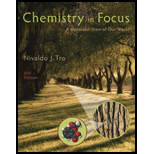
Interpretation:
The four types of contaminants that are found in water with two examples each are to be listed.
Concept Introduction:
Water is a common liquid that is present on the Earth.
It is also known as universal solvent. It can dissolve a wide range of organic and inorganic solutes.
Water is vital for the existence of all living animals. Without water, no life form can exist, it constitutes an important part of rivers, lakes, streams, clouds, snow and ice.
Water is truly an unusual molecule such that being a low molar mass compound, it exists as a liquid at room temperature and has an anonymously high boiling point.
Ice floats on water because it has a lower density than water.
Water contains some unwanted particles which can lead to diseases and other hostile effects on human health.
Water acts as a good solvent, so numerous particles and microbes can contaminate water.
Biological contaminants: Some microbes can live in water and can cause various diseases like cholera, dysentery, and so on. Two examples of such microbes are Giardia and Legionella.
Inorganic contaminants: Some inorganic molecules can dissolve in water and make it impotable (not suited for drinking). Two examples of such molecules are Nitrates and Asbestos.
Organic contaminants: Some organic molecules can dissolve in water and makes it impotable (not suited for drinking). Two examples of such molecules are chlorohydrocarbons (volatile) and ethylbenzene (non-volatile).
Radioactive contaminants: Some radioactive elements can dissolve in water and make it impotable (not suited for drinking). Two examples of such elements are Uranium and Radium.
Want to see the full answer?
Check out a sample textbook solution
Chapter 12 Solutions
Chemistry In Focus
- Make these conversions for atmospheric concentrations: (a) CO: 35 ppm to percent; (b) NO2: 0.053 ppm to ppb.arrow_forwardConsider the following solubility graph. (a) At point A, how many grams of the compound are dissolved in 100 g of water? Is the solution saturated, unsaturated, or supersaturated? (b) At point B, how many grams of the compound are dissolved in 100 g of water? Is the solution saturated, unsaturated, or supersaturated? (c) How would you prepare a saturated solution at 30C?arrow_forwardWhat mass of a 4.00% NaOH solution by mass contains 15.0 g of NaOH?arrow_forward
- How much CaCl2 , in grams, is needed to make 2.0 L ofa 3.5M solution?arrow_forwardHow many grams of sucrose would you add to water to make a total of 1.3 L of 12% solution(mass per volume)?arrow_forwardHow many grams of sucrose would you add to water to make a total of 1.5 L of 8% solution (mass per volume)?arrow_forward
- A Pb-concentrated water sample contains 0.0011% Pb by mass. How much of the water (in mL) contains 150 mg of Pb? (Assume a density of 1.0 g/mL)arrow_forwardA saline solution contains 1.1% NaCl by mass. How much NaCl is present in 96.3 g of this solution?arrow_forwardWhat are the concentrations of chemicals interest to water treatment and potable water supply systems and determine if they are present in the raw and treated water?arrow_forward
- What category of environmental chemistry that deals with chemical phenomena in all types ofwater and natural waters?arrow_forwardThe maximum safe level of each compound in drinking water is given below. Convert each value to parts per million. a. chloroform (CHCl 3, a solvent), 80 μg/kg b. glyphosate (a pesticide), 700 μg/kgarrow_forwardThe maximum safe level of each metal in drinking water is given below. Convert each value to parts per million. a. copper, 1,300 μg/kg b. arsenic, 10 μg/kg c. chromium, 100 μg/kgarrow_forward

 Introductory Chemistry: A FoundationChemistryISBN:9781337399425Author:Steven S. Zumdahl, Donald J. DeCostePublisher:Cengage Learning
Introductory Chemistry: A FoundationChemistryISBN:9781337399425Author:Steven S. Zumdahl, Donald J. DeCostePublisher:Cengage Learning Chemistry by OpenStax (2015-05-04)ChemistryISBN:9781938168390Author:Klaus Theopold, Richard H Langley, Paul Flowers, William R. Robinson, Mark BlaserPublisher:OpenStax
Chemistry by OpenStax (2015-05-04)ChemistryISBN:9781938168390Author:Klaus Theopold, Richard H Langley, Paul Flowers, William R. Robinson, Mark BlaserPublisher:OpenStax Chemistry: The Molecular ScienceChemistryISBN:9781285199047Author:John W. Moore, Conrad L. StanitskiPublisher:Cengage Learning
Chemistry: The Molecular ScienceChemistryISBN:9781285199047Author:John W. Moore, Conrad L. StanitskiPublisher:Cengage Learning Chemistry: Principles and ReactionsChemistryISBN:9781305079373Author:William L. Masterton, Cecile N. HurleyPublisher:Cengage LearningChemistry: Matter and ChangeChemistryISBN:9780078746376Author:Dinah Zike, Laurel Dingrando, Nicholas Hainen, Cheryl WistromPublisher:Glencoe/McGraw-Hill School Pub Co
Chemistry: Principles and ReactionsChemistryISBN:9781305079373Author:William L. Masterton, Cecile N. HurleyPublisher:Cengage LearningChemistry: Matter and ChangeChemistryISBN:9780078746376Author:Dinah Zike, Laurel Dingrando, Nicholas Hainen, Cheryl WistromPublisher:Glencoe/McGraw-Hill School Pub Co





